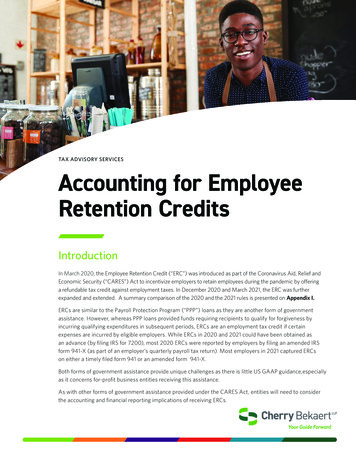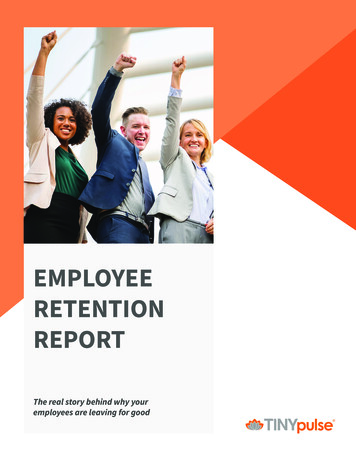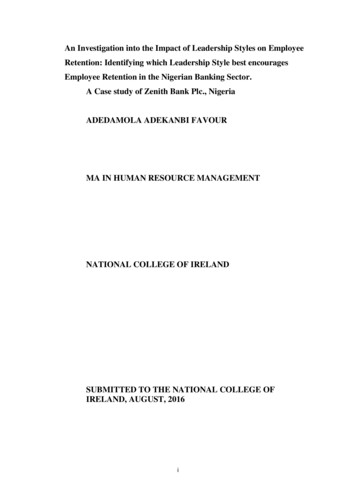
Transcription
TAX ADVISORY SERVICESAccounting for EmployeeRetention CreditsIntroductionIn March 2020, the Employee Retention Credit (“ERC”) was introduced as part of the Coronavirus Aid, Relief andEconomic Security (“CARES”) Act to incentivize employers to retain employees during the pandemic by offeringa refundable tax credit against employment taxes. In December 2020 and March 2021, the ERC was furtherexpanded and extended. A summary comparison of the 2020 and the 2021 rules is presented on Appendix I.ERCs are similar to the Payroll Protection Program (“PPP”) loans as they are another form of governmentassistance. However, whereas PPP loans provided funds requiring recipients to qualify for forgiveness byincurring qualifying expenditures in subsequent periods, ERCs are an employment tax credit if certainexpenses are incurred by eligible employers. While ERCs in 2020 and 2021 could have been obtained asan advance (by filing IRS for 7200), most 2020 ERCs were reported by employers by filing an amended IRSform 941-X (as part of an employer’s quarterly payroll tax return). Most employers in 2021 captured ERCson either a timely filed form 941 or an amended form 941-X.Both forms of government assistance provide unique challenges as there is little US GAAP guidance,especiallyas it concerns for-profit business entities receiving this assistance.As with other forms of government assistance provided under the CARES Act, entities will need to considerthe accounting and financial reporting implications of receiving ERCs.
Executive SummarySimilar to the PPP, entities may elect to account for ERCsunder one of several accounting principles. Unlike PPP, ERCswill not be accounted for under ASC Topic 470: Debt. Rather,the following accounting standards may be leveraged whendetermining the appropriate accounting of ERCs: International Accounting Standards (IAS) 20,Accounting for Government Grants and Disclosureof Government AssistanceAccounting under Subtopic 958-605If the entity receives ERCs as an advance, it will recorda liability for the cash received until such time that theconditions to earn the credit are substantially met. Whenconditions are met, a not-for-profit entity is required torecord the income as revenue, while a for-profit entitymay record the amount as grant revenue or other income.Subtopic 958-605 does not permit an entity to net thegrant against qualifying costs.Determination of AppropriateAccounting PrincipleThe evaluation of whether all conditions are substantiallymet will require the use of judgment. Uncertainty regardingwhether an entity qualifies for the credit would generallyindicate that the conditions were not substantially met atperiod end. Since the accounting model under Subtopic958-605 requires that substantially all conditions are met torecognize the grant into income, entities will need to considerwhether preparing and submitting the filing is a “more thanadministrative task” that would defer recognition until suchtime that the filing with the Internal Revenue Service is made.Business entities should account for ERCs using one of thesestandards after considering which standard would provide themost transparency to the users of their financial statements.Under Subtopic 958-605, the entity would present theamount of an employment tax refund receivable or anunearned refund advance as a current asset or liability.ERCs, unlike PPP loans, are structured as a refundable creditand not a loan. If an entity accounted for their PPP loansunder IAS 20 or ASC 958, there is a presumption that theywill utilize the same guidance to account for their ERCs.Entities that accounted for their PPP loans under ASC 470,Debt will have to determine the appropriate guidance toreference from the options enumerated above.All not-for-profit entities that receive government grantsshould apply ASC 958-605. Application of IAS 20 or ASC450 would be appropriate only for for-profit enterprises. ASC 958-605, Not-for-Profit Entities— Revenue Recognition ASC 450-30, ContingenciesAccounting under IAS 20Pursuant to IAS 20, a business entity would recognize ERCson a systematic basis over the periods in which the entityrecognizes the payroll expenses for which the grant (i.e., taxcredit) is intended to compensate the employer when thereis reasonable assurance (i.e., it is probable) that the entitywill comply with any conditions attached to the grant and thegrant (i.e., tax credit) will be received.IAS 20 permits presentation as a credit in the incomestatement (either separately or under a general heading, suchas “other income”) or as a reduction of the related expense(with appropriate disclosure in the footnotes regarding keyfeatures of the grant). This guidance is not available to notfor-profit entities.Accounting under Subtopic 450-30Application of ASC 450-30 may also be appropriate forfor-profit enterprises. Under ASC 450, entities would treatthe ERCs (whether received in cash or as an offset to currentor future payroll taxes) as if they were gain contingencies.When applying ASC 450-30, entities would not considerthe probability of complying with the terms of the ERCprogram but, rather, would defer any recognition in theincome statement until all uncertainties are resolved andthe income is “realized” or “realizable”. This approach willlikely result in later recognition than in the other approachesdiscussed herein.
SUMMARY OF POTENTIAL APPROACHES:StandardNon-ProfitBusinessEntitiesIAS 20NoYesAccount for the ERC as a conditional contribution, recognizing the grantrevenue as the entity “substantially meets” the program requirements(i.e. as the qualifying expenditures are incurred and any barriers toentitlement are overcome).ASC 958605YesYesAccount for the ERC only when all uncertainties regarding its realizationhave been resolved. Typically, this will result in entities deferring recognitionof other income until their employment tax return has been processed andthey are entitled to the funds.ASC 45030NoYesDescription of Accounting TreatmentDevelop a pattern to recognize the ERC (either as non-operating income ora contra-expense) that approximates the pattern by which the entity incursthe necessary costs that allowed them to qualify for the ERC.COMPARISON OF POTENTIAL APPROACHES:Consider the following fact pattern:XYZ Associates (“XYZ”), a calendaryear-end entity, faced economichardship as a result of the COVID-19pandemic but chose to keep their W-2employees on the payroll. Accordingly,XYZ applied for refundable credits forthe following periods:Submission date of IRSForm 7200 or 941Period Covered by filingMarch 31, 2021First quarter, 2021 200,000July 1, 2021Second quarter, 2021 180,000August 31, 2021Third quarter, 2021 150,000Amount claimed 530,000
The following is a comparison of how XYZ would account for the ERC’s for financial reporting purposes under each of theapproaches enumerated above:Accounting DateIAS 20ASC 958-605ASC 450First QuarterXYZ would record 200,000of either non-operating incomeor contra-expense (*) and areceivable as the qualifyingpayroll expenditures were incurredin the quarter ended 3/31/21.XYZ would record 200,000of either grant income orcontra-expense (**) and areceivable as the qualifyingpayroll expenditures wereincurred in the quarter ended3/31/21 and the entity had filedthe required forms with the IRS.XYZ would not record anythingin the first quarter as there arestill uncertainties regarding theacceptance of the filing by theIRS. Based on materiality, itmay be a disclosure event. XYZwould recognize the incomestatement impact of the IRSonly upon all uncertaintiesbeing lifted (e.g., upon receiptof the funds or formal notice bythe IRS that they are entitled tosuch funds).Second QuarterXYZ would record 180,000of non-operating income orcontra-expense (*) for the quarterended 6/30/21 despite not yetfiling the required form with theIRS if they have “reasonableassurance” (i.e. it is probable)that the Company incurred thequalifying expenditures duringthe quarter.XYZ would have to determineif “substantially all” of the conditions have been met to earnthe credit (since the underlyingfiling had not been completed at6/30/21). If such filing is considered to be solely administrative,then XYZ would record 180,000of grant income or other income(**) and record a receivable. Ifsuch filing is considered to be“more than administrative”, thenthere would be no accounting asof 6/30/2021 until all barriers toentitlement had been overcome.XYZ would not record anythingin the second quarter as thereare still uncertainties regardingthe acceptance of the filing bythe IRS. Based on materiality, itmay be a disclosure event. XYZwould recognize the incomestatement impact of the IRSonly upon all uncertaintiesbeing lifted (e.g., upon receiptof the funds or formal notice bythe IRS that they are entitled tosuch funds).Third QuarterXYZ is filing for the ERC on8/31/21 for the quarter ended9/30/21. As of the filing dateon 8/31/21, XYZ would recorda receivable for 150,000,non-operating income orcontra-expense (*) of 100,000(2/3 of the total as 2 months ofqualifying expenditures have beenincurred for the quarter as of thefiling date) and 50,000of deferred income.XYZ would defer all 150,000upon completing the IRS filingsas “substantially all” expenditureshave not been incurred as of thefiling date (e.g. not all barriers toentitlement had been overcome).Once all qualifying expenditureshave been made, XYZ wouldrecord the income statementimpact of the ERC.XYZ would not record anythingin the third quarter as there arestill uncertainties regarding theacceptance of the filing by theIRS. Based on materiality, itmay be a disclosure event. XYZwould recognize the incomestatement impact of the IRSonly upon all uncertaintiesbeing lifted (e.g., upon receiptof the funds or formal notice bythe IRS that they are entitled tosuch funds).(*) If recording contra-expense, XYZ would need to include adequate disclosures informing financial statement users of the quantitative impact of suchcontra expenses(**) If XYZ is a for-profit entity, they may present the income statement impact of the ERC as other income. If XYZ is a not-for-profit entity, they must recordthe income statement impact of the ERC as grant revenue
Auditor ResponseThe auditor should consider the risks of materialmisstatement for ERCs in the design of the audit approach.ERCs in excess of tolerable misstatement are a requiredconsultation matter. If you meet this threshold, you arerequired to send the client’s support for their claimedERCs to Marty Karamon martin.karamon@cbh.comand/or Deb Walker dwalker@cbh.com for their review.Minimum DisclosureSimilar to disclosure requirements for PPP loans, the entityshould disclose its accounting policy for ERCs and theirimpact on the financial statements. Disclosures shouldinclude information about the accounting model applied,significant terms of the program, and a description ofthe relevant line items and amounts recognized withinthe financial statements. When amounts have not beenrecognized in the income statement because conditionshave not been substantially met, these conditions should bedisclosed. This includes any amount expected to be receivedand any amounts recognized on the balance sheetif estimable.ConclusionAccounting for ERCs (and similar government supportpayments for for-profit entities) has little US GAAP guidance.Accordingly, management will have to exercise judgment inselecting the appropriate framework under which to recordand report ERCs. If applicable, ensure that the frameworkselected by management to account for ERCs is the sameas the framework selected for PPP loans. While there maybe no “right” answer, we should ensure as much as possiblethat the approach taken is consistent and the disclosuresregarding ERCs clearly communicate the details of thetransaction to the users of the financial statements.Let Us Be Your Guide ForwardMartin Karamon, J.D., LL.M.Principal, Tax Servicesmartin.karamon@cbh.comDeborah Walker, CPADirector, Tax ServicesCredits & Accounting Methods LeaderDWalker@cbh.comRoy E. Amler, CPA, CMAPartner, Assurance Servicesramler@cbh.comJon FreySenior Manager, Assurance Servicesjfrey@cbh.com
APPENDIX IERC Rules: 2021 vs. 2020ERC2020 RULES2021 RULESCredit ApplicabilityQualified wages: Paid after March 12, 2020 and on orbefore December 31, 2020Qualified wages: Paid on or after January 1, 2021 and on orbefore September 30, 2021Credit TypeRefundable payroll tax credit to eligible employersRefundable payroll tax credit to eligible employersCredit Amount50% of qualified wages (other than wages used for PPPloan forgiveness, paid sick leave and FMLA wages, orWOTC wages).50% of qualified wages (other than wages used for PPPloan forgiveness, supporting a restaurant revitalizationgrant, or a shuttered venue operators grant, research ordevelopment grant, paid sick leave and FMLA wages, orWOTC wages).Government Mandate Test: Employers (including taxexempt orgs.) carrying on a trade or business during2020 with respect to any calendar quarter whereoperations (including those of suppliers) are fully orpartially suspended due to orders from an appropriategovernmental authority limiting commerce, travel orgroup meetings due to COVID-19Government Mandate Test: Employers (including taxexempt orgs.) carrying on a trade or business during 2021where operations (including those of suppliers) are fullyor partially suspended due to orders from an appropriategovernmental authority limiting commerce, travel or groupmeetings due to COVID-19Gross Receipts Test: Employers of any size carrying ona trade or business and tax-exempt organizations thatduring a calendar quarter of 2020 had less than 50% ofgross receipts in the same calendar quarter during theprior yearGross Receipts Test: Employers of any size carrying on atrade or business or tax-exempt organizations that duringa calendar quarter of 2021 have less than 80% of grossreceipts in the same calendar quarter during 2019Eligible EmployerStatus continues until 2021 or, if earlier, the quarterfollowing the quarter when gross receipts returnto 80% or more of the gross receipts for that samecalendar quarter as the prior yearQualified WagesMax CreditEntities that did not exist in the first two quarters of 2019substitute the corresponding quarter in 2020Option to compare immediately preceding quarter to thecorresponding quarter in 2019Calculate at controlled group levelCalculate at controlled group levelEmployers with more than 100 full-time employeesin 2019 determined on a controlled group basis:Wages paid by an eligible employer to employees notperforming servicesEmployers with more than 500 full-time employeesin 2019 determined on a controlled group basis: Wagespaid by an eligible employer to employees not performingservicesInclude the eligible employer’s qualified health planexpensesInclude the eligible employer’s qualified health planexpensesLimit: 10,000 per employeeLimit: 10,000 per employee, per quarterEmployers with 100 or fewer full-time employees in2019 determined on a controlled group basis: Wagespaid by an eligible employer to all employeesEmployers with 500 or fewer full-time employees in 2019determined on a controlled group basis: Wages paid by aneligible employer to all employeesInclude the eligible employer’s qualified health planexpensesInclude the eligible employer’s qualified health planexpensesLimit: 10,000 per employee limitLimit: 10,000 per employee, per quarter 5,000 per employee 21,000 per employeecbh.comAbout Cherry Bekaert 2021 Cherry Bekaert LLP. All Rights Reserved. This material has been prepared forgeneral informational purposes only and is not intended to be relied upon as tax,accounting, or other professional advice. Before taking any action, you should consult aprofessional advisor familiar with your particular facts and circumstances.v. 11.18.2021 TL Accounting for Employee Retention Credits 784009778
under one of several accounting principles. Unlike PPP, ERCs will not be accounted for under ASC Topic 470: Debt. Rather, the following accounting standards may be leveraged when determining the appropriate accounting of ERCs: International Accounting Standards (IAS) 20, Accounting for Government Grants and Disclosure of Government Assistance










